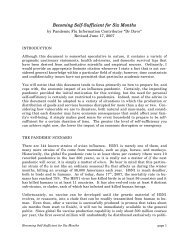You also want an ePaper? Increase the reach of your titles
YUMPU automatically turns print PDFs into web optimized ePapers that Google loves.
B Temporarily tie down the strands to<br />
prevent the rope unlaying further.<br />
C Tuck strand 1 over an opposing strand<br />
and under the next strand.<br />
D Bring strand 2 over strand 5 and under<br />
the next one.<br />
E Bring strand 3 over strand 6 and under<br />
the next one. You have now completed<br />
the first tuck.<br />
F Remove the temporary tie and repeat<br />
the operation described above on the<br />
other rope end. Continue tucking the<br />
strands in sequence until you have<br />
done four tucks on each rope. Trim the<br />
ends.<br />
To taper the splice, finish several complete<br />
tucks on each rope, then remove the<br />
whippings from the strands. With a sharp<br />
knife or razor cut about one third of the<br />
yarns from each strand. Retwist the yarns,<br />
whip as before, and make another full<br />
tuck. Again, untwist and slice about one<br />
third of the remaining yarn of each strand<br />
for the remaining tuck.<br />
For synthetic rope, follow the same<br />
method as mentioned above, but allow one<br />
additional tuck (with or without tapering).<br />
Docker’s Splice<br />
The Docker’s Splice is sometimes called<br />
the Marline Eye Splice or the Tucked Eye<br />
Splice. It is the easiest of all to form. It is a<br />
quick method of making a temporary eye a<br />
rope at any point and is often used on<br />
ridge tents to hold the dolly of the main<br />
guylines.<br />
In most splices the lay of the rope is<br />
opened and the tucks are made with the<br />
rope strands. In the Docker’s Splice the<br />
whole rope is used.<br />
Open the lay at the chosen point in the<br />
rope and tuck the whole of the running end<br />
through the raised strand to make an eye of<br />
the required size (A).<br />
Now open the lay of the standing part of<br />
the rope immediately below the first tuck<br />
and pull the running end through until both<br />
tucks lock together (B).<br />
As in all splices, remember to work<br />
against (or across) the lay. After the<br />
second tuck make sure that the running<br />
end is of reasonable length so that there is<br />
no danger of it pulling out.
















